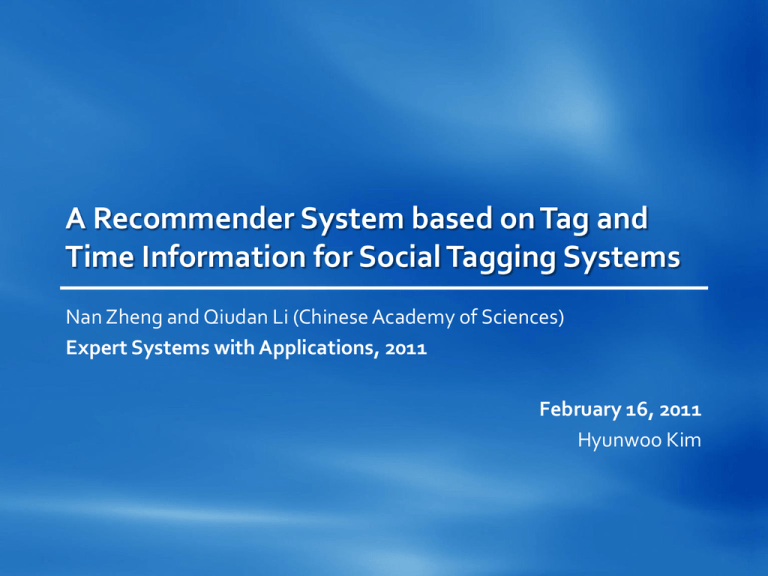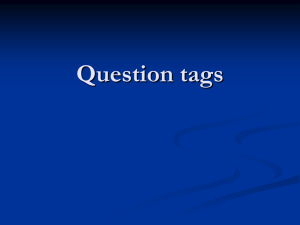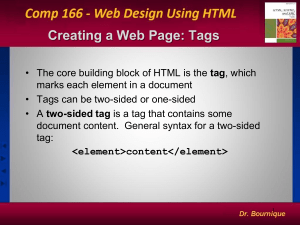A Recommender System based on Tag and Time Information for
advertisement

A Recommender System based on Tag and Time Information for Social Tagging Systems Nan Zheng and Qiudan Li (Chinese Academy of Sciences) Expert Systems with Applications, 2011 February 16, 2011 Hyunwoo Kim Outline Introduction Proposed Approach A Recommender System Experimental Evaluation Conclusion Introduction Tag Time - Interests of a user - Bridge between a user and a resource - First posting date - The latest posting date - Posting frequency 3 Introduction Time?? - Page creation date Web Page 4 Introduction Tags – Reflects the interest of a user as time goes by For example, – Alice often uses baby health and education her bookmarks Alice baby health in 2006 education in 2011 5 Introduction A resource-recommendation model – Providing personalized services in social tagging systems – By three phases Rating generation User similarity calculation Resource recommendation Three strategies to generate ratings – Tag-weight strategy – Time-weight strategy – Tag and time strategy 6 Proposed Approach Two matrices – User-resource binary matrix If a user has bookmarked a resource, the value is 1 Otherwise 0 User – Modified user-resource rating matrix Resource 1 0 0 1 1 0 0 1 1 Involving either tags, time, or both tag and time Tag-weight: tag frequency of a user Time-weight: time weight value Tag and time: the value of the integration of tag weight value and time weight value Resource User 7 0.5 0 0 0.3 0.7 0 0 0.1 0.9 Proposed Approach The framework of resource-recommendation model 8 Proposed Approach - Rating Generation Tag-weight strategy – Assumption The more a tag has been used, the more interests the user has in the related resource A user is likely to prefer the resources bookmarked with the high frequency tags – Tag weight is defined as tag(u,r): the set of tags with which a user u has bookmarked to a resource r wu,ta: tag score of each tag ta in tag(u,r) 9 Proposed Approach - Rating Generation Time-weight strategy – Assumption Human interests drift as time goes by – To learn and track the changes of user’s behavior Time window Exponential forgetting function – Time weight defined as time(u,r): non-negative integer. The value of 0 for the last tagging day and the value of 1 for the penultimate tagging day, and so on hlu: half-life for each user 10 Proposed Approach - Rating Generation Tag and time strategy – Combining two weights into a single one – Tag and time weight defined as Linear combination of tag weight and time weight – In order to denote user’s preference more accurately Tags indicate user’s degree of preferences Bookmarked time reflects interest drifts of a user 11 Proposed Approach An example 12 A Recommender System The architecture of the recommender system History browsing: tagging history browsing and tag browsing User network construction: network is constructed according to user similarity Resource recommendation: proposed model and log-based model 13 A Recommender System Tag browsing 14 A Recommender System Log-based model 15 A Recommender System Proposed resource-recommendation model 16 Experimental Evaluation Evaluation metrics – Hit-rate and hit-rank m: the total number of users h: the number of hits pi: positions 17 Experimental Evaluation Tag’s impact 18 Experimental Evaluation Time’s impact 19 Experimental Evaluation Model with both tag and time information 20 Conclusion In this paper – Proposing a resource-recommendation model to utilize tag and time information Tag, time and both tag and time outperform traditional log-based model – Building a recommender system to provide personalized resource recommendation Future work – Evaluating proposed resource-recommendation model with other datasets – Extending to social network analysis in social tagging systems 21 Thank You






